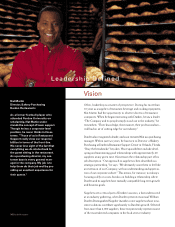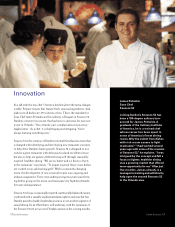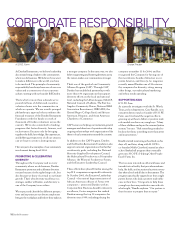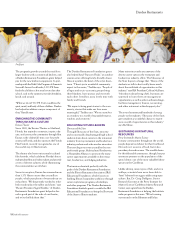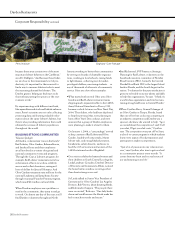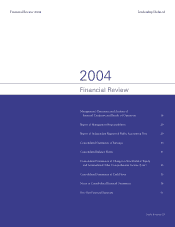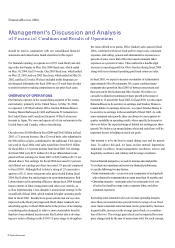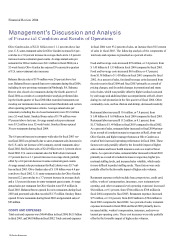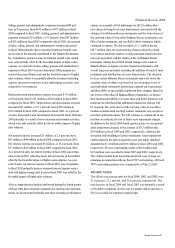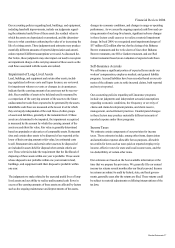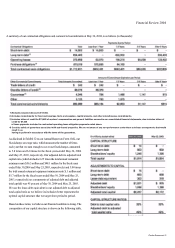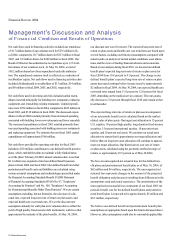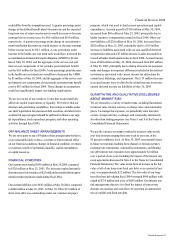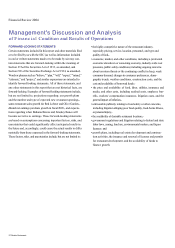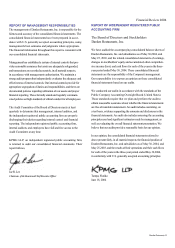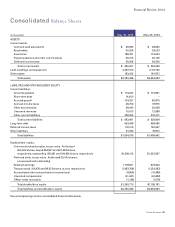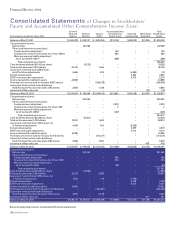Red Lobster 2004 Annual Report Download - page 26
Download and view the complete annual report
Please find page 26 of the 2004 Red Lobster annual report below. You can navigate through the pages in the report by either clicking on the pages listed below, or by using the keyword search tool below to find specific information within the annual report.
Financial Review 2004
Management's Discussion and Analysis
of Financial Condition and Results of Operations
NET EARNINGS AND NET EARNINGS PER SHARE
Net earnings for fiscal 2004 were $231 million ($1.36 per diluted
share) compared with net earnings for fiscal 2003 of $232 million
($ 1.31 per diluted share) and net earnings for fiscal 2002 of $238 mil-
lion ($ 1.30 per diluted share).
Net earnings for fiscal 2004 decreased 0.3 percent and diluted net
earnings per share increased 3.8 percent compared to fiscal 2003.
The decrease in net earnings was primarily due to the $38 million
pre-tax ($23 million after-tax) asset impairment and restructuring
charges recognized during fiscal 2004 related to the closing of six
Bahama Breeze restaurants and write-down of another four Bahama
Breeze restaurants, one Olive Garden restaurant, and one Red
Lobster restaurant. Net earnings were also impacted by decreases
in food and beverage costs as a percent of sales, which were only
partially offset by increases in restaurant labor, restaurant expenses,
selling, general, and administrative expenses, and depreciation and
amortization expense as a percent of sales. The increase in diluted
net earnings per share is due to a reduction in the average diluted
shares outstanding from fiscal 2003 to fiscal 2004 because of our
continuing repurchase of our common stock.
Net earnings for fiscal 2003 decreased 2.3 percent and diluted net
earnings per share increased 0.8 percent, compared to fiscal 2002.
The decrease in net earnings was primarily due to increases in res-
taurant labor, restaurant expenses, and depreciation and amortiza-
tion expenses as a percent of sales, which were only partially offset
by decreases in food and beverage costs and selling, general, and
administrative costs as a percent of sales. The increase in diluted
net earnings per share was due to a reduction in the average diluted
shares outstanding from fiscal 2002 to fiscal 2003 because of our
continuing repurchase of our common stock.
SEASONALITY
Our sales volumes fluctuate seasonally. During fiscal 2004, 2003,
and 2002, our sales were highest in the spring, lowest in the fall, and
comparable during winter and summer. Holidays, severe weather,
and similar conditions may impact sales volumes seasonally in some
operating regions. Because of the seasonality of our business, results
for any quarter are not necessarily indicative of the results that may
be achieved for the full fiscal year.
IMPACT OF INFLATION
We do not believe inflation had a significant overall effect on our
operations during fiscal 2004, 2003, and 2002. We believe we have
historically been able to pass on increased operating costs through
menu price increases and other strategies.
CRITICAL ACCOUNTING POLICIES
We prepare our consolidated financial statements in conformity
with accounting principles generally accepted in the United States
of America. The preparation of these financial statements requires
us to make estimates and assumptions that affect the reported
amounts of assets and liabilities and disclosure of contingent
assets and liabilities at the date of the financial statements, and
the reported amounts of sales and expenses during the reporting
period. Actual results could differ from those estimates.
Critical accounting policies are those we believe are both most
important to the portrayal of our financial condition and operat-
ing results, and require our most difficult, subjective or complex
judgments, often as a result of the need to make estimates about
the effect of matters that are inherently uncertain. Judgments and
uncertainties affecting the application of those policies may result
in materially different amounts being reported under different con-
ditions or using different assumptions. We consider the following
policies to be most critical in understanding the judgments that are
involved in preparing our consolidated financial statements.
Land, Buildings, and Equipment
Land, buildings, and equipment are recorded at cost less accu-
mulated depreciation. Building components are depreciated over
estimated useful lives ranging from seven to 40 years using the
straight-line method. Leasehold improvements, which are reflected
on our consolidated balance sheets as a component of buildings, are
amortized over the lesser of the lease term or the estimated useful
lives of the related assets using the straight-line method. Equipment
is depreciated over estimated useful lives ranging from two to
10 years, also using the straight-line method. Accelerated deprecia-
tion methods are generally used for income tax purposes.
26 Darden Restaurants


